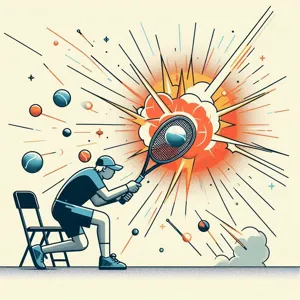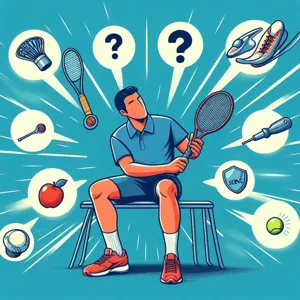The tennis serve is often described as the most critical shot in the game, setting the tone for each rally and giving players a chance to assert their dominance from the very first point.
Whether you’re a budding amateur or an aspiring professional, mastering the serve can elevate your game and provide you with a competitive edge on the court. But perfecting this powerful stroke requires more than just strength; it demands a blend of technique, precision, and mental focus. In this blog post, we will explore essential tips that will help you develop a powerful tennis serve, from understanding your grip and stance to refining your toss and follow-through. With the right guidance and practice, you’ll learn how to serve like a pro and leave your opponents scrambling to keep up. Get ready to transform your game, one serve at a time!
1. Understanding the Importance of a Strong Serve

A powerful serve is often the cornerstone of a successful tennis game. It sets the tone for each point and can give you a distinct advantage over your opponent right from the start. Unlike other shots in tennis, the serve is unique in that it is the only stroke that you have complete control over, allowing you to dictate both pace and placement. A strong serve not only puts immediate pressure on your opponent but also opens up the court for the shots that follow.
The psychological impact of a formidable serve cannot be overstated. A well-executed serve can intimidate your opponent, making them second-guess their return strategy and thereby opening the door for unforced errors. Conversely, a weaker serve can embolden your opponent, giving them confidence to attack and take control of the point.
In addition, a powerful serve can create opportunities for quick points, allowing you to dominate the game without giving your opponent a chance to settle in. As you master different types of serves—such as the flat serve, kick serve, and slice serve—you’ll not only increase your arsenal but also keep your opponent guessing, making it more challenging for them to read your play.
Ultimately, understanding the importance of a strong serve is about more than just technique; it’s about recognizing how it can influence the pace of the match, affect your opponent’s confidence, and elevate your overall game. By dedicating time to develop your serve, you are setting yourself up for greater success on the court, turning each serve into a potent weapon that can lead you to victory.
2. The Anatomy of a Tennis Serve
Understanding the anatomy of a tennis serve is crucial for any player looking to enhance their game. A powerful serve is not merely a display of strength; it’s a harmonious blend of technique, timing, and body mechanics that work together to deliver that perfect shot.
To break it down, the serve can be divided into several key components: stance, grip, toss, swing, and follow-through. Let’s explore each of these elements to unlock the secrets of a successful serve.
**Stance:** Your starting position sets the tone for the entire serve. Stand with your feet shoulder-width apart, knees slightly bent, and body angled sideways to the net. This stance not only provides stability but also allows for a fluid transition into your swinging motion.
**Grip:** The way you hold your racket is paramount. The most common grips for serving are the Continental grip and the Eastern grip. The Continental grip allows for versatility in spin and placement, while the Eastern grip can provide more power. Experiment with both to find which best suits your playing style.
**Toss:** A consistent toss is the backbone of a reliable serve. The ball should be tossed in front of you, slightly to your dominant side, and at a height that allows you to connect with it at the highest point of your reach. Practice your toss separately to develop a rhythm that feels natural and reliable.
**Swing:** The swing is where the magic happens. Begin by bringing your racket back in a smooth, controlled motion. As you make your forward swing, shift your weight from your back foot to your front foot, generating power from your legs and core. The racket should come forward in a fluid arc, striking the ball at the peak of your toss. Focus on generating a full range of motion, as this is key for both power and spin.
**Follow-Through:** After making contact with the ball, a proper follow-through is essential. Allow your racket to continue its motion across your body, which not only helps with accuracy but also reduces the risk of injury. A good follow-through signals that you’ve executed the serve correctly and prepares you for the next shot.
By mastering each of these components, players can develop a serve that is not only powerful but also precise. Remember, consistency is key; practice each element in isolation before putting them all together. With time and dedication, you’ll be serving like a pro and leaving your opponents scrambling to return your powerful shots.
3. Grip Techniques: Finding What Works for You

When it comes to developing a powerful tennis serve, mastering the grip is one of the most critical factors that can make or break your game. The grip you choose not only influences your control but also the spin and power of your serve. There are several different grip techniques to consider, each offering its own set of advantages depending on your playing style and comfort level.
The most common grips used in serving are the Continental grip, the Eastern grip, and the Western grip. The Continental grip, often favored by professionals, allows for a versatile serve that can easily transition between flat, slice, and topspin serves. To achieve this grip, hold the racket as if you’re shaking hands with it; your index knuckle should rest on the second bevel of the racket handle. This grip gives you the flexibility to hit a variety of serves while also providing a solid foundation for power.
Alternatively, the Eastern grip can add more topspin to your serve, making it a great choice for players looking to gain a tactical edge with high-bouncing balls. To use the Eastern grip, place your index knuckle on the third bevel, positioning your hand slightly more underneath the racket. This grip can create a flatter trajectory and can be particularly effective when combined with a strong follow-through.
Lastly, the Western grip, while less common for serves, can provide an extreme topspin effect, which is perfect for those who want to keep their opponents on their toes with high, unpredictable shots. However, it requires a lot of practice to master, as it can be challenging to generate the necessary power.
Regardless of the grip you choose, the key is experimentation. Spend time on the court trying out each grip to see which feels most comfortable and natural for you. Consider recording yourself serving with different grips to analyze the power and spin you can generate. By understanding and fine-tuning your grip techniques, you’ll not only enhance your serving game but also build the confidence needed to dominate the court. Remember, finding what works for you is a journey—embrace the process, and your serve will evolve into a powerful weapon in your tennis arsenal.
4. Stance and Positioning: Setting Up for Success
The foundation of a powerful tennis serve lies in your stance and positioning. This critical first step is often overlooked by beginners, but mastering it can dramatically enhance both your power and accuracy. Start by positioning your feet shoulder-width apart, with your non-dominant foot slightly in front of the other. This alignment not only provides a solid base but also helps with balance as you prepare to launch the ball.
Weight distribution is another key aspect. Shift your weight slightly onto your back foot, allowing you to generate more power when you explode forward into your serve. As you prepare to toss the ball, ensure that your knees are slightly bent, ready to spring into action. This athletic stance not only improves your stability but also allows for a smooth transfer of energy from your legs through your torso and into your arm.
Your positioning on the court is equally important. Stand a few feet behind the baseline to give yourself ample room for the upward motion of your serve. If you’re serving from the deuce side, angle your body slightly towards the right of the court, and vice versa for the ad side. This orientation not only helps you target your serves more effectively but also keeps your opponent guessing.
Finally, don’t forget about your grip. A continental grip is often recommended for serves, as it allows for versatility in spin and placement. With all these elements combined—proper stance, weight distribution, court positioning, and grip—you’re setting up for a serve that can command attention and dominate your matches. Embrace these fundamentals, and watch as your serving game transforms, making each serve not just a hit, but a statement.
5. The Toss: Key Elements for a Consistent Serve

The toss is one of the most critical components of a successful tennis serve, acting as the foundation upon which your entire motion is built. A consistent and well-executed toss can make the difference between a powerful ace and a frustrating fault. To master this essential element, focus on three key aspects: height, placement, and timing.
First and foremost, the height of your toss is crucial. Ideally, the ball should be tossed high enough so that you have ample time to swing your racket beneath it, but not so high that it becomes difficult to track. A good rule of thumb is to toss the ball to a height where it peaks just above your outstretched racket. This allows for a fluid motion as you hit the ball at the optimal point.
Next, consider the placement of your toss. For a right-handed player, the ball should be thrown slightly to the right of your body, allowing you to comfortably pivot and reach for the shot. The toss should also be in line with your intended target—whether you’re aiming for the service box or planning a powerful serve down the line. Experimenting with slight adjustments in placement can help you find what feels most natural and effective for your style of play.
Finally, timing your toss is essential for establishing a rhythm in your serve. The toss should be an extension of your body’s natural movement, flowing seamlessly into your swing. A common mistake is tossing too late or too early, which can disrupt your timing and result in inconsistent serves. Practice developing a smooth, synchronized motion, where the toss and the racket swing occur in harmony.
By honing these key elements of the toss, you’ll not only enhance your serve’s consistency but also build confidence in your overall game. Remember, a solid toss is the secret ingredient that propels your serve from mediocre to magnificent, enabling you to dominate the court with every powerful delivery.
6. Developing a Fluid Serving Motion
A fluid serving motion is the cornerstone of a powerful and effective tennis serve. It’s not just about strength; it’s about rhythm and grace. Picture the greats of the game—each serve is a symphony of movement, where every part of the body works in harmony to create speed and precision.
To develop this fluidity, start by focusing on your stance. Stand with your feet shoulder-width apart, knees slightly bent, and weight balanced. This foundation is crucial as it allows for a smooth transfer of energy from your legs through to your racket. As you prepare to serve, visualize the motion as a continuous flow, rather than a series of abrupt movements.
Begin your motion with the racket held high, then smoothly drop it down and back as you toss the ball with your non-dominant hand. The key here is to synchronize the ball toss with your racket’s downward swing. A common mistake is to rush the toss; instead, let it rise in a controlled manner, allowing your racket to meet it at the peak of its ascent.
As you accelerate through the serve, engage your core and rotate your hips, letting this natural movement guide your arm. Your follow-through is just as important; allow your racket to continue its path after contact, which not only adds power but also enhances your overall motion.
Practicing this fluidity will not only improve your serve’s effectiveness but will also reduce the risk of injury. A smooth, controlled motion allows your body to adapt and respond efficiently, making your serve not just powerful, but consistent. Remember, the best serves are those that look effortless—so with each practice session, aim to refine your technique until it flows like water.
7. Power vs. Placement: Finding the Right Balance

When it comes to mastering the tennis serve, the age-old debate of power versus placement often arises. While the thrill of sending a blistering serve whistling past your opponent can be exhilarating, it’s crucial to recognize that a well-placed serve can be just as formidable, if not more so. Striking the right balance between these two elements can elevate your game and keep your opponents guessing.
Power is undoubtedly an exciting aspect of serving; a strong serve can put immediate pressure on your opponent and set the tone for the rally. However, raw power without precision can often lead to unforced errors or easy returns. A serve that lands out of bounds or into the net is a missed opportunity, regardless of its speed. Therefore, it’s vital to channel that power into a controlled motion that allows for both speed and accuracy.
On the other hand, placement involves strategically targeting specific areas of the service box to exploit your opponent’s weaknesses. A well-placed serve that targets the corners or the body can disrupt your opponent’s rhythm, forcing them to adjust their position and response. This approach not only minimizes the likelihood of a powerful return but can also open up the court for a follow-up shot, giving you an advantageous position in the rally.
To find the right balance, practice is essential. Spend time honing your serving technique to incorporate both speed and accuracy. Use drills that focus on serving to specific targets within the service box, gradually increasing your power as you refine your placement. Additionally, consider your opponent’s strengths and weaknesses—sometimes a powerful serve is necessary, while other times, a smartly placed serve is the best tactic.
Ultimately, a successful serve is one that keeps your opponent on their toes. By developing the ability to combine power with precision, you’ll become a more versatile player, capable of adapting your strategy to match the demands of each match. Remember, it’s not just about how hard you can serve; it’s about how effectively you can control the game from the very first point.
8. Types of Serves: Flat, Slice, and Kick Explained
Understanding the different types of serves is crucial for any tennis player looking to elevate their game. Each serve has its unique characteristics and advantages, tailored to exploit your opponent’s weaknesses or to ensure your own success on the court. Here, we’ll break down the three primary types of serves: flat, slice, and kick.
**Flat Serve:** The flat serve is a staple in the arsenal of many professional players. Characterized by its speed and minimal spin, this serve is executed with a fast, powerful motion, sending the ball rocketing toward the opponent’s service box. The flat serve is particularly effective on fast surfaces like hard courts, where speed can catch opponents off guard. However, mastering this serve requires precise timing and placement, as even a slight miscalculation can lead to faults. When executed correctly, the flat serve can become a formidable weapon, allowing you to dictate the pace of the match right from the start.
**Slice Serve:** The slice serve adds a layer of complexity to your serving strategy. By imparting sidespin on the ball, this serve curves toward the sideline, making it challenging for opponents to anticipate and return effectively. The slice serve is particularly useful for pulling your opponent wide off the court, opening up space for your next shot. This serve is versatile, ideal for both first and second serves, and especially effective on grass and clay courts. To master the slice serve, focus on the angle of your racket face and the brushing motion as you make contact with the ball, ensuring it spins away from your opponent.
**Kick Serve:** The kick serve is a favorite among advanced players for its high bounce and unpredictability. This serve is executed with a combination of topspin and sidespin, causing the ball to rise sharply after it contacts the ground. The kick serve is particularly advantageous on clay courts, where the extra bounce can disrupt an opponent’s rhythm. It’s also an excellent choice for second serves, as its high trajectory minimizes the risk of faults while still challenging your opponent. To achieve the desired effect, practice brushing up on the ball with an open racket face, ensuring that you generate enough spin to create that signature kick.
By mastering these three types of serves—flat, slice, and kick—you can keep your opponents guessing and enhance your overall game strategy. Each serve has its time and place, so experiment with them during practice to discover which works best for your playing style. With dedication and practice, you’ll be serving like a pro in no time!
9. Drills to Improve Your Serve
Improving your tennis serve requires a blend of technique, strength, and practice, and the best way to hone these elements is through targeted drills. Incorporating specific exercises into your training routine can help refine your mechanics, increase your power, and boost your overall confidence on the court.
**1. Basket Drills:** One of the simplest yet most effective drills is the basket drill, where you practice serving from various positions on the court. Set up a basket filled with tennis balls and focus on hitting your serves with precision. Start by targeting specific areas of the service box, such as the corners or the T, and gradually increase the speed and power of your serves as you become more comfortable. This drill helps in developing consistency and accuracy.
**2. The Toss Drill:** A solid serve begins with a flawless toss. To perfect this fundamental aspect, practice your toss separately. Stand in your serving position and toss the ball without hitting it. Pay attention to the height and placement of your toss, ensuring it is in line with your hitting shoulder. This drill can be done anywhere and will help you develop muscle memory, leading to a more reliable serve during games.
**3. Serve and volley:** To improve your serve under match conditions, try the serve and volley drill. Serve the ball and immediately move to the net to practice your volleys. This exercise not only enhances your serving skills but also prepares you for the quick transitions required in matches. It helps you to develop a rhythm and understand how to react after your serve.
**4. Target Practice:** Set up targets in the service box using cones or hula hoops. As you serve, aim for these targets to improve your accuracy. This drill encourages you to focus on placement rather than just power and is essential for developing a strategic serve that can outmaneuver your opponents.
**5. partner Drills:** Working with a partner can provide instant feedback and keep your practice engaging. Take turns serving to each other, focusing on different spins and placements. Your partner can call out where to serve next, challenging you to adapt your strategy and improve your decision-making skills during play.
Integrating these drills into your practice routine will not only enhance your serving skills but will also make your training sessions more enjoyable. Remember, consistency is key; the more you practice, the more powerful and effective your serve will become. So grab those tennis balls and get ready to elevate your game!
10. Common Mistakes and How to Fix Them
When it comes to developing a powerful tennis serve, recognizing common mistakes can be just as crucial as mastering the technique itself. Even seasoned players may find themselves falling into bad habits that can hinder their performance on the court. Here, we’ll outline some of these pitfalls and provide effective strategies to correct them, ensuring your serve reaches its full potential.
**1. Inconsistent Toss:** One of the most frequent errors players make is an inconsistent ball toss. A stable toss is the foundation of a reliable serve. If you’re tossing the ball too high or too low, or if it’s drifting sideways, your serve will lack precision. **Fix:** Practice your toss separately. Focus on releasing the ball at the same height consistently—ideally around eye level. A good drill is to practice tossing without hitting the ball, allowing you to concentrate solely on the toss mechanics.
**2. Poor Stance:** Many players overlook the importance of a solid stance. A weak or unbalanced position can lead to poor serve execution and increased risk of injury. **Fix:** Ensure that your feet are shoulder-width apart, with your non-dominant foot slightly ahead. This stance offers stability and allows for a full rotation of your body during the serve. Spend time practicing your footwork, as a good serve begins with a strong base.
**3. Lack of Follow-Through:** A common misconception is that the power of the serve comes solely from the initial swing. However, a proper follow-through is essential for both power and control. **Fix:** After making contact with the ball, allow your racket to continue its path naturally. Your follow-through should be smooth and fluid, with your racket finishing high above your shoulder. Practicing shadow swings can help reinforce this motion without the pressure of hitting a ball.
**4. Tension in the Arm:** Tension can be the enemy of a fluid serve. Players often grip their rackets too tightly, leading to stiffness and a lack of power. **Fix:** Focus on relaxing your grip. Consider using a lighter grip pressure, allowing for a more natural swing. Incorporating breathing exercises into your practice routine can also help you stay relaxed and focused.
**5. Neglecting Spin:** Many players may serve with just power in mind, neglecting the benefits of spin. A flat serve can be effective, but incorporating spin can add an element of unpredictability. **Fix:** Experiment with different types of serves, such as topspin or slice. Start slowly, focusing on your racket angle and the point of contact to generate spin. Over time, you’ll find a comfortable balance between power and spin that works for your style.
By identifying and rectifying these common mistakes, you can elevate your serve from mediocre to exceptional. Remember, practice is key, and each session is an opportunity to refine your technique. Stay patient and persistent, and soon enough, you’ll find your serve becoming a powerful weapon on the court!
11. Mental Focus: The Psychology of Serving
When it comes to mastering the art of serving in tennis, the importance of mental focus cannot be overstated. Serving is not just about technique; it’s a psychological game that can determine the outcome of a match. The moment you step up to the baseline, the pressure mounts. You’re not just facing your opponent; you’re confronting the expectations you’ve set for yourself, the distractions around you, and the desires of the crowd watching in anticipation.
To serve like a pro, cultivating a strong mental game is essential. This begins with visualization. Before you even toss the ball, take a moment to picture the serve you want to execute. Envision the ball soaring over the net and landing precisely in the service box where you intend. By creating a mental image of your success, you can build confidence and reduce anxiety.
Mindfulness is another key component of mental focus. In the heat of a match, it can be easy to get swept away by the adrenaline or bogged down by negative thoughts. Practicing mindfulness techniques, such as deep breathing or grounding exercises, can help center your thoughts and bring your attention back to the present moment. This focus will enable you to block out distractions and maintain your composure, even when the stakes are high.
Moreover, developing a pre-serve routine can significantly enhance your mental focus. This routine should consist of a series of actions that you perform consistently before every serve. Whether it’s bouncing the ball a certain number of times, adjusting your grip, or taking a deep breath, these actions help signal to your brain that it’s time to focus. A well-established routine can create a sense of familiarity and calm, allowing you to approach each serve with confidence and clarity.
Lastly, embrace the power of positive self-talk. The narrative you tell yourself can drastically influence your performance. Replace negative thoughts with affirmations that reinforce your abilities. Phrases like “I am a strong server” or “I can handle this pressure” can transform your mindset and lead to a more powerful serve.
In summary, serving effectively requires not only physical skill but also a fortified mental approach. By honing your psychological strategies—visualization, mindfulness, a consistent routine, and positive self-talk—you can develop a powerful serve that not only impresses your opponents but also boosts your overall game. Remember, the serve is often the first step in a rally; make it count by mastering the mental game behind it.
12. Conditioning and Strength Training for Serves
Conditioning and strength training are cornerstone elements that can elevate your tennis serve from average to exceptional. While technique and timing are critical, the physical prowess behind your serve can make all the difference in speed, accuracy, and consistency.
To start, focus on building overall body strength, particularly in your core, shoulders, and legs. These muscle groups are integral to a powerful serve. Exercises such as squats, lunges, and deadlifts will help develop leg strength, providing a solid base to generate power. Meanwhile, incorporating medicine ball throws and planks will engage your core, which is crucial for transferring energy through your body and into the ball.
Don’t overlook the upper body! Resistance training that targets your shoulders and arms can enhance your serving capacity. Try incorporating exercises like shoulder presses, rows, and rotator cuff exercises to build stability and strength in these areas. Strengthening these muscles not only improves your serve but also helps prevent injuries, which can sideline your progress.
In addition to traditional strength training, agility and conditioning drills are essential. High-intensity interval training (HIIT) can significantly improve your cardiovascular fitness, ensuring you maintain energy throughout matches. Plyometric exercises, like box jumps and burpees, can also boost your explosiveness, allowing you to generate maximum power during your serve.
Finally, don’t forget about flexibility and mobility. Incorporating dynamic stretching and yoga into your routine can enhance your range of motion, enabling you to achieve the optimal serving motion. This combination of strength, conditioning, and flexibility training will not only enhance your serve but also contribute to your overall performance on the court.
By dedicating time to conditioning and strength training, you’ll develop a serve that’s not just powerful but also reliable, keeping your opponents on their toes and your game at its peak.
13. Analyzing Professional Players: What We Can Learn
When it comes to mastering the art of serving in tennis, there’s perhaps no better resource than the pros themselves. Analyzing professional players offers invaluable insights into the nuances of a powerful serve, showcasing the techniques that elevate their game and keep their opponents on their toes.
Take a moment to watch the serving styles of top players like Roger Federer, Serena Williams, or Novak Djokovic. Notice how they effortlessly combine power and precision, using their whole body to generate momentum. Their footwork is impeccable, with a strong base providing the stability needed to unleash a forceful serve. Focus on their grip and racquet positioning—each player has a unique style, yet they all share common elements that contribute to their effectiveness.
One key takeaway from these pros is the importance of rhythm and consistency. Many professional players have a specific routine they follow before each serve, which helps them maintain focus and composure under pressure. This mental aspect is just as crucial as physical technique, as it allows them to replicate their form time after time.
It’s also worthwhile to observe how they adapt their serves based on their opponents. Some players excel at mixing up their serves—alternating between powerful flat serves, spin serves, and tricky placements to keep their rivals guessing. This strategic versatility can provide significant advantages during crucial points in a match.
Incorporating lessons learned from professional players into your own practice can dramatically enhance your serving skills. Whether it’s perfecting your toss, refining your timing, or working on your follow-through, there’s a wealth of information to draw from. By analyzing the best, you not only gain practical tips but also inspire yourself to push your limits and elevate your game. Embrace these insights, and watch as your serve transforms into a powerful weapon on the court.
14. The Role of Equipment: Choosing the Right Racket and Strings
When it comes to developing a powerful tennis serve, the right equipment can make all the difference. Your racket and strings are not just tools; they are extensions of your playing style and can significantly influence your performance on the court.
Start with your racket choice. A racket that feels comfortable and suits your skill level is essential. For a powerful serve, look for a racket with a larger head size, which provides a bigger sweet spot and more forgiveness on off-center hits. Heavier rackets generally offer more stability and power, while lighter ones can enhance your swing speed. It’s crucial to find a balance that feels right for you—test a few rackets to see which one complements your playing style best.
Next, consider the strings. The tension and type of strings you choose can impact the spin and control of your serve. For added power, lower tension strings can give you a trampoline effect, allowing the ball to spring off the racket with more velocity. On the other hand, higher tension strings tend to provide better control, making it easier to place your serves with precision. Additionally, the material of the strings—whether polyester, multifilament, or natural gut—can affect both durability and feel.
Experimenting with different combinations of rackets and strings can be a game-changer. Don’t hesitate to consult with a local pro shop for personalized advice tailored to your skill level and playing style. Remember, investing time in the right equipment is as vital as perfecting your technique; it can help you unleash the full potential of your serve and elevate your game to new heights.
15. Creating a Serve Practice Routine for Continuous Improvement
Creating a serve practice routine is crucial for continuous improvement in your tennis game. A well-structured routine not only enhances your skill but also builds muscle memory, allowing you to execute your serve with precision and confidence in high-pressure situations.
Start by setting specific goals for your practice sessions. Assess which aspects of your serve need the most attention—whether it’s your toss, grip, or follow-through. Perhaps you struggle with consistency or power. By identifying these areas, you can tailor your routine to focus on improvement.
Begin each session with a warm-up to prepare your body. This should include dynamic stretches and light footwork drills to get your muscles engaged and ready for action. Once you’re warmed up, dedicate time to practice your toss. A consistent toss is the foundation of a powerful serve, so spend ample time ensuring it’s height and placement are reliable.
Next, break down your serve into components. Start with shadow swings without the ball to focus on your stance and motion. Gradually introduce serves, beginning with half-speed attempts to concentrate on technique. As you gain confidence, increase your speed and power while remaining mindful of your form.
Incorporate targets into your practice. Setting up cones or using marked areas on the court can help you work on accuracy and placement. Challenge yourself to hit these targets consistently, varying your serve types—flat, slice, and kick—to develop versatility.
Lastly, track your progress. Keep a journal of your practice sessions, noting improvements and areas that still need work. This reflection will motivate you to stay disciplined and focused on your goals. With a consistent serve practice routine, you’ll be well on your way to mastering one of the most crucial elements of your game, ensuring you serve like a pro on every court you step onto.
In conclusion, mastering the art of a powerful tennis serve is not just about raw strength; it’s about technique, precision, and practice. By incorporating the essential tips outlined in this article—such as perfecting your grip, honing your footwork, and developing a consistent toss—you can elevate your serve from average to exceptional. Remember, every great player started as a beginner, and with dedication and the right mindset, you can transform your serve into a formidable weapon on the court. So, grab your racket, hit the practice courts, and serve like a pro. Your opponents won’t know what hit them!





















